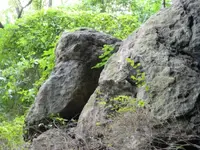To follow up on my earlier post, consider these couple pics of Athena busts. Note the very 'Egyptian' looking headdress:
View attachment 1034796
Here is a different one, with some interesting things to discuss:
View attachment 1034797
Much talk about wisdom and owls surrounding Athena, but there is more. The helmet represents secrecy. The spear is representative of enlightenment (Lance of Longinus?...?). Both Athena and Apollo are Shakers of the Spear at the Dragon of Ignorance. This leads into a HUGE tangent about who Shakes Spear (Shakespeare) really was. Apollo also has the Sun God thing going on.
The serpent in the statue represents at least two things. It symbolizes the serpents that guard the child Athena took from Gaia (Mother Earth) as well as the child himself. The serpent, beyond that, is a well used symbol. Here is a pic of Athena receiving her child:
View attachment 1034809
Concerning that image from a vase, c.a. 420 BC:
It depicts the birth of the 'Earth-born One' (Erichthonios). Earth (Gaia) presents the new-born child to Athena, who represents the reborn serpent-friendly Eve after the Flood. The figure to the left of Gaia and the child is Hephaistos, the eldest son of Zeus and Hera, the deified Kain. According to one version of the myth surrounding this event, Athena obtained the sperm, or seed, of Hephaistos (Kain), and placed it into the Earth, and out of Earth sprang the rejuvenated line of Kain after the Flood. The essence of ancient Greek religion is very simple. After the Flood, which caused the line of Kain to disappear into the earth, Athena, the reborn serpent-friendly Eve, nurtures the reborn line of Kain which re-emerges from the earth into which it had disappeared. Another, darker version of the myth says Erichthonios is Athena’s own child, born after her father, the winged-God Pallas, raped her.
Notice the checkerboard decoration on Athena's garb: her helmet and cuirass are checked black and white [White and black checkerboard floor of the Masons]. The helmet is feathered, harking back to Athena’s archaic origins as a bird goddess, and the owl is prominently featured, hovering above Athena’s right shoulder. Although it is a little unclear in the image, the black edging or trim on her gown (possibly meant to represent the Aegis) ends in the heads of two serpents.
Concerning Athena's heritage:
Archaic Athena is not a Greek goddess, she predates them and her name does not have a Greek etymology. She is an echo of an ancient goddess, perhaps a bird goddess. In the classical Greek period, Athena was associated with an owl, "wisdom" (perhaps a remnant of her bird goddess origins). In poetry from Homer onward, Athena's most common epithet is glaukopis, which is usually translated "bright-eyed" or "with gleaming eyes." It is a combination of glaukos ("gleaming," "silvery," and later, "bluish-green" or "gray") and ops ("eye," or sometimes, "face"). Glaux, "owl," is from the same root, presumably because of its own distinctive eyes. The bird that sees in the night is closely associated with the goddess of wisdom: in archaic images, she is frequently depicted with an owl perched on her head.
There are some nasty bird/lady type beings that predate Athena. Something important about that eye thing and its relation to an owl's eye. I have posted this before, the Seal of Colorado, also the State flag around Scarlet Shadow time:
View attachment 1034821
That is not the 'Eye of God', like we are told - that is, of course, unless God is an owl ...
The design for the Territorial Seal which served as a model for the State Seal or Great Seal of Colorado has been variously credited, but the individual primarily responsible was Lewis Ledyard Weld, the Territorial Secretary, appointed by President Lincoln in July of 1861. There is also evidence that Territorial Governor William Gilpin also was at least partially responsible for the design. Both Weld and Gilpin were knowledgeable in the art and symbolism of heraldry. Elements of design from both the Weld and Gilpin family coat-of-arms are incorporated in the Territorial Seal.
Gilpin County is where Central City and Blackhawk are, the epicenter and beginnings of the 1860's gold rush. Weld County is north east of Denver and where the town Greeley, of Horace Greeley, editor of the New York Times and who penned "Go west, young man," concerning the Colorado Gold Rush, is.





